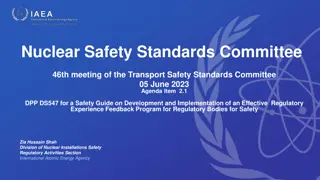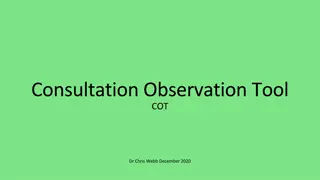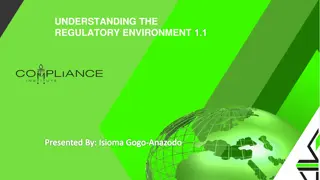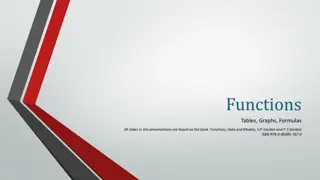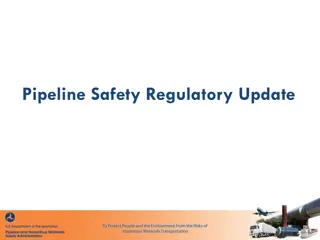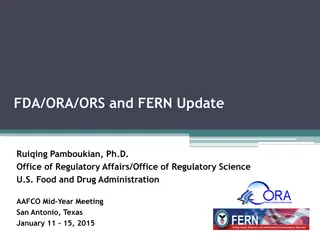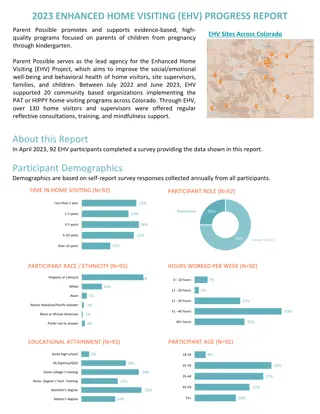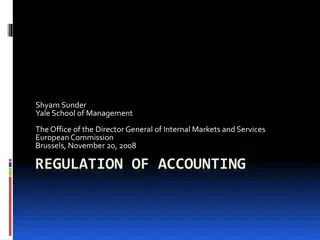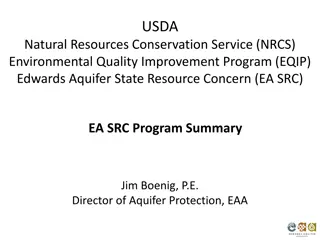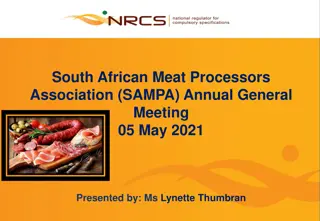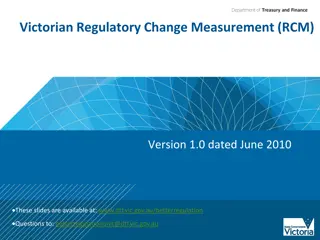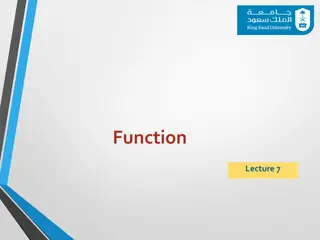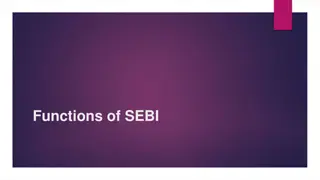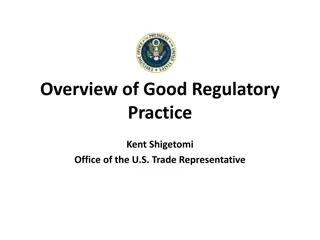Overview of NRCS Consultations and Regulatory Functions
The National Regulator for Compulsory Specifications (NRCS) held consultations in November 2016 discussing operational and financial performance, alongside strategic goals and legislative mandates. The organization aims to ensure compliance with technical regulations across various industries it regulates. NRCS's mission is to develop and administer compulsory specifications while educating stakeholders about its role as a credible regulator. The NRCS derives its mandate from specific legislative acts and regulates industries such as automotive, building materials, electrical appliances, and more.
Download Presentation

Please find below an Image/Link to download the presentation.
The content on the website is provided AS IS for your information and personal use only. It may not be sold, licensed, or shared on other websites without obtaining consent from the author.If you encounter any issues during the download, it is possible that the publisher has removed the file from their server.
You are allowed to download the files provided on this website for personal or commercial use, subject to the condition that they are used lawfully. All files are the property of their respective owners.
The content on the website is provided AS IS for your information and personal use only. It may not be sold, licensed, or shared on other websites without obtaining consent from the author.
E N D
Presentation Transcript
NRCS Levy Consultations November 2016 1
NRCS representation Mr. Edward Mamadise Acting Chief Executive Officer Ms. Reshma Mathura Chief Financial Officer Ms. Elmarie Cornelius Financial Manager Mr Bongani Khanyile General Manager Electrotechnical Ms Meisie Katz General Manager FAI 2
Scope of Presentation Strategic Overview of the NRCS NRCS Operational performance NRCS Financial performance Fee and Tariff proposal 3
NRCS Strategy, Mission and Vision NRCS Strategic Goals Mission & Vision Mission To develop compulsory specifications and technical regulations, and maximise compliance of regulated products and services Vision A credible and respected regulator for the protection of the public, the economy and the environment To develop, maintain and administer compulsory specifications and technical regulations To ensure an optimally capacitated institution To maximise compliance with all specifications and technical regulations To inform and educate our stakeholders about the NRCS 5
Legislative Mandate Mandate of the NRCS is derived from the following Acts. National Regulator for Compulsory Specifications Act (Act No. 5 of 2008) Legal Metrology Act (Act No. 9 of 2014) National Building Regulations and Building Standards Act (Act No. 103 of 1977) The Foodstuffs, Cosmetics and Disinfectants Act (Act 54 of 1972) 6
Industries regulated by NRCS Industry Sector Automotive Product regulated / Service rendered Vehicles, Replacements components, Manufacturers Importers and Builders Building materials (Cement. Treated timber, Safety glass and other safety glazing material). PPE (Safety Footwear, Swimming aids, personal flotation devices, respirators Electrical appliances and products, Electronic appliances and products Fishery products, canned meat and processed meat Chemicals, Materials and Mechanicals Electro-technical Foods and Associated Industries (FAI) Legal Metrology Verification of measuring instruments, type approval of measuring instruments, calibration in fields of mass and volume, designation of verification laboratories, Verification Officer examinations, E-mark Registration and LOCs for gaming equipment Ensure uniform interpretation of National Building Regulations and Standards Act, administer review Board Building Regulations 7
Organisational performance Operational Performance Financial Performance 8
NRCS Successes IPAP: Lock in and Lock out principles implemented Non-compliant products to the value of R204,85 million were removed from the market. The NRCS conducted 50 509 inspections The NRCS issued 9 457 approval certificates for Electro-technical, Automotive and Chemicals, Materials and Mechanicals products Issued 10 233 health guarantees which ensured that all exported fishery and associated products were accepted in foreign markets. Developed, withdrew and/or amended eight compulsory specifications (VCs) and submitted for approval to the Minister. These VCs were for Live Lobsters, Lamp Holders, Flexible Cords, Medium Voltage Electric Cables, Electric Cables with Extruded solid dielectric (300/500V to 1900/3300V) 2 Technical Papers developed and approved by the CEO for publication Corporate social investment (Safe paraffin stove campaign) Levy Audit successes (R9.5m in Q2 of 2017) 9
Challenges and strategies Challenges Inadequate testing facilities in South Africa for some regulated products e.g. Motor cycle helmets. Capacity constraints, given resources available Escalating cost of regulation Importation of products without NRCS Approval Generation of revenue reliant on trends and markets. Non-compliant levy payers Internal control weaknesses ICT system Strategies SARS & NRCS Collaboration (Code alignment project) NRCS and other government departments & entities System modernisation Border enforcement Levy collections and under-declarations Meeting the current LOA turnaround times 10
Financial Status: Income Statement Surplus 400,000,000 350,000,000 300,000,000 250,000,000 200,000,000 Rands 150,000,000 100,000,000 50,000,000 - (50,000,000) 2010 2011 2012 2013 2014 2015 2016 2017 (B) 336,401,362 374,446,952 (38,045,590) Total Income Total Expenditure Surplus 158,051,199 151,389,882 6,661,317 182,861,789 157,224,803 25,636,986 201,570,554 185,352,277 16,218,277 261,738,942 224,105,507 37,633,435 290,842,252 245,959,399 44,882,853 330,925,710 278,513,588 52,412,122 309,926,876 308,310,807 1,616,069 11
Financial Status: Revenue 2016 Revenue Surplus 6% 350,000,000 14% 300,000,000 250,000,000 50% 200,000,000 Rands 150,000,000 30% 100,000,000 50,000,000 - 2010 158,051,1 182,861,7 201,570,5 261,738,9 290,842,2 330,925,7 309,926,8 Total Expenditure 151,389,8 157,224,8 185,352,2 224,105,5 245,959,3 278,513,5 308,310,8 Surplus 6,661,317 25,636,98 16,218,27 37,633,43 44,882,85 52,412,12 1,616,069 2011 2012 2013 2014 2015 2016 Total Income Levies Core funding Services Other Income 12
Financial Status: Revenue Revenue 350,000,000 300,000,000 250,000,000 200,000,000 Rands 150,000,000 100,000,000 50,000,000 - 2010 2011 2012 2013 2014 2015 2016 2017 (B) 181,178,385 86,418,000 50,204,977 18,600,000 336,401,362 Levies Core funding Services Other Income Total Income 82,531,041 35,933,000 28,752,685 10,834,473 158,051,199 100,490,917 33,042,000 30,073,187 19,255,685 182,861,789 125,384,427 37,173,000 33,731,205 5,281,922 201,570,554 136,576,092 79,684,000 33,380,667 12,098,183 261,738,942 139,236,692 103,000,000 33,511,745 15,093,815 290,842,252 166,436,828 109,734,000 41,329,839 13,425,043 330,925,710 154,590,878 91,732,000 45,223,056 18,380,942 309,926,876 13
Completeness of levies Levies are incomplete/ inaccurate due to: Bona fide error If a levy payer has incorrectly classified the levy commodity which they import or manufacture a bona fide error has been made. Lists of regulated products are available on the NRCS website www.nrcs.org.za and technical specialists are available to advise. Under-declaration The NRCS has the right to request any information it deems necessary for a period of five years. If under-declaration is suspected notify a levy officer. A levy auditor will then be dispatched to follow up. Non-submission of returns As at the end of October 2016, 53% of the levy returns due to the NRCS had not been submitted yet. A levy is the equivalent of a tax If the NRCS does not recognise all levies due to it, its revenue is incomplete A combination of levy audits and follow up on outstanding levies attempts to address this 14
Levy Declaration: Deadlines According to the Standards of GRAP: A levy is the equivalent of a tax A tax must be recognized at the date of the taxable event A taxable event for a levy happens when manufacture or import occurs Therefore levies need to be aligned to the NRCS s financial year Mandatory declarations were introduced to achieve this Type of Mandatory Levy period 1 Mandatory Levy period 2 submission declaration 1 (Period A) declaration 2 (Period B) 1 January 31 1 January 30 1 July 30 1 July 31 Period March annually June annually September annually December covered annually Levy declaration Mandatory Levy declaration Mandatory Submission declaration Period A & payment declaration Period B & payment 30 April annually 31 July annually 31 October annually 31 January Due date for annually submission A period (January to June) A period (January to June) B period (July to December) Mandatory declaration Mandatory declaration March March NRCS Financial year (April to March) 15
Financial areas highlighted Successes Strengthened Levy Audit function Compliance check on applications (levy, debtors, fees) Challenges Non-compliant industry (levy declarations, payment) Adverse economic conditions Declining government funding Key strategies Automation of the NRCS levy declaration function Levy audit focus on non compliance (under-declaration, incorrect declaration, non- declaration) Email statements 16
Proposal for increases Overall proposal A fixed increase equal to CPI. CPI calculated as at end of September 2016 = 6% applicable to both levies and fees. Exceptions Fees Legal Metrology (LM) Levy tariffs Foods and Associated Industries (FAI) 17
Legal Metrology: Rationale Scope Legal metrology fees Rationale for approach Benchmarking exercise conducted by NRCS Fees charges by NRCS are significantly lower than industry Legal Metrology is funded by government grant, which is reducing Approach Adjustment of fees to match industry tariffs based on a benchmarking exercise conducted. These fees are applicable to verification and type approval services. 18
Legal Metrology: Proposal for increases Charged for 2016/2017 per hour Industry average per hour Proposed charge 2017/2018 per hour % Service increase Inspector time R 402.00 R 611.00 R 603.00 50% Assistant time R 121.00 R 182.00 50% Travelling time - inspector R 269.00 R 611.00 R 603.00 124% Travelling time - assistant R 121.00 R 182.00 50% Travelling time - driver R 269.00 R 345.00 R 285.00 6% Equipment rental - rail R 1 607.00 R 1 703.00 6% Equipment rental - road R 810.00 R 1 723.00 R 1 723.00 113% 19
FAI: Rationale Scope FAI Levies Rationale for FAI proposed increases Fee disparity between low volume and high volume producers SMME s disadvantaged financially Intra-Industry cross subsidisation To provide a more equitable basis of pricing between high volume producers/ importers and low volume producers/ importers FAI unit not fully funded Loss of R 12m Levy increase alternatives Levy scale review Single scale for levies 20
Proposal for increases - FAI CPI increase for 14 commodities Levy code Description Canned crustaceans (VC8014) Old tariff New Tariff % increase 767 696 696 165 165 711 5710 5714 5715 5719 5720 5727 724 657 657 155 155 671 6% 6% 6% 6% 6% 6% Canned marine molluscs (other than abalone) (VC8014) Fish paste (VC8014) Frozen marine molluscs and frozen marine mollusc products (other than mussels) (VC8017) 5728 5736 5741 5742 5751 5752 671 222 148 148 897 897 711 235 157 157 951 951 6% 6% 6% 6% 6% 6% Smoked snoek (VC 8021) Frozen crabs (VC8031) Canned abalone (VC8014) Live aquacultured abalone (VC9001) 5753 9104 433 473 459 501 6% 6% Live lobster VC 9104 21
Proposal for increases - FAI Single tariff for 8 Commodities 2017 Tariffs Frozen rock lobster tails, leg and breast meat (VC8020) Frozen whole rock lobster, cooked and uncooked (VC8020) Frozen rock lobster tails, leg and breast meat (VC8020) Frozen whole rock lobster, cooked and uncooked (VC8020) Frozen cephalopods (VC8017) Frozen mussels (VC8017) Scale range Scale parity Average 5730 308 14 14 2181% 161 5734 308 14 14 2181% 161 5743 700 135 135 419% 418 5744 700 135 135 419% 418 5745 631 631 246 157% 439 5746 631 631 246 157% 439 5748 308 14 14 2181% 161 5749 308 14 14 2181% 161 - 10 20 Proposal Scale range Scale parity Average 5730 75 75 75 0% 75 5734 75 75 75 0% 75 5743 300 300 300 0% 300 5744 300 300 300 0% 300 5745 300 300 300 0% 300 5746 300 300 300 0% 300 5748 75 75 75 0% 75 5749 75 75 75 0% 75 - 10 20 Average increase -53% -53% -28% -28% -32% -32% -53% -53% 22
Proposal for increases - FAI 2017 Tariffs Canned fish and canned fish products (other than fish paste) (VC8014) Frozen unpackaged (loose) fish & ungutted, boxed fish (VC8017) Frozen prawns, shrimps, langoustines and crabs (VC8031) Canned meat and canned meat products (VC8019) Frozen fish and frozen fish products (VC8017) Scale range Scale parity Average 5711 750 750 313 313 85 56 56 56 1235% 403 5712 750 750 313 313 85 56 56 56 1235% 403 5716 766 766 222 222 196 196 94 94 715% 430 5717 766 766 222 222 196 196 94 94 715% 430 5721 694 694 158 158 39 24 24 17 3982% 356 5722 694 694 158 158 39 24 24 17 3982% 356 5725 414 414 94 94 22 15 15 10 3979% 212 5739 1 055 942 942 264 264 264 264 264 300% 660 5740 1 055 942 942 264 264 264 264 264 300% 660 - 2 10 12 60 560 1 000 2 560 Proposal Scale range Scale parity Average 5711 335 335 335 335 124 85 85 85 294% 210 5712 335 335 335 335 124 85 85 85 294% 210 5716 289 289 289 289 210 210 101 101 186% 195 5717 289 289 289 289 210 210 101 101 186% 195 5721 231 231 231 231 160 62 62 45 413% 138 5722 231 231 231 231 160 62 62 45 413% 138 5725 160 160 160 160 137 30 30 30 433% 95 5739 659 659 659 390 390 390 390 390 69% 525 5740 659 659 659 390 390 390 390 390 69% 525 - 2 10 12 60 560 1 000 2 560 Average increase -48% -48% -55% -55% -61% -61% -55% -20% -20% 23
End Comments 24




